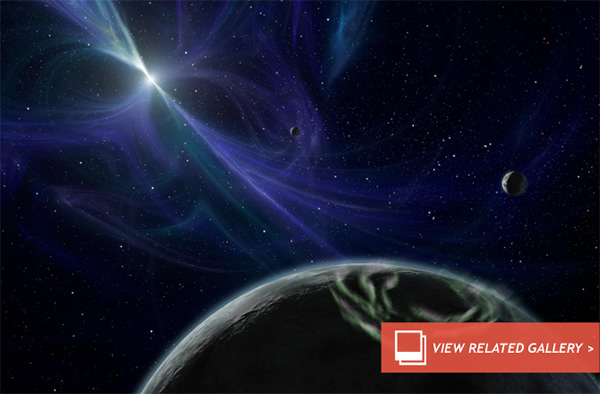Pulsar Gets the Munchies, Snacks on an Asteroid
Pulsars are cosmic time keepers. They are rapidly-spinning neutron stars — the superdense remnants of massive stars gone supernova — generating very focused beams of radiation from their magnetic poles. As their poles sweep in our direction, the pulse of radiation can be detected and their timing measured. They act like lighthouses, emitting bright beams of light, blinking in the night.
Usually, these pulses are ultra-accurate and astronomers have been able to deduce that they lose energy, gradually decreasing their spin rate. But occasionally, their spin rate can abruptly change for no apparent reason. There are a few theories as to why these rapidly-spinning neutron stars hiccup every now and then, but generally the phenomenon is poorly understood.
In research accepted for publication in the Astrophysical Journal, astronomers documented the anomalous spin rate of a pulsar that has been observed “multiple times” between 1988 and 2012. In September 2005, the spin rate of the well-observed PSR J0738-4042 changed and a team of astronomers headed by Paul Brook, of the University of Oxford, think they know why.
“The data lead us to postulate that we are witnessing an encounter with an asteroid or in-falling debris from a disk,” they write in a paper published to the arXiv pre-print service.
It stands to reason that debris from a star system may persist after the parent star has gone supernova, leaving a rapidly-spinning pulsar in its wake. Planetary bodies, asteroids, dust and gas will therefore collect around the pulsar in the form of a disk. The gravity of the pulsar will inevitably drag some of that mass into it. After some extreme physics right near the surface of the dense matter, the in-falling matter will abruptly alter the pulsar’s spin rate and its radiation signature, two distinct signals that PSR J0738-4042 generated in 2005.
The researchers calculated that a mass of a billion tons dropped into the pulsar’s magnetosphere, the effects of which can be observed today. As the mass, presumably a moderately-sized asteroid, fell into the pulsar’s magnetosphere, getting shredded and material ionized — akin to a magnetic blender. The highly-charged particles from the ex-asteroid then got trapped in the pulsar’s magnetic field, blasting out energy and bleeding the spinning stellar husk of its angular momentum, or spin, causing the observed slowdown in pulses.
Interestingly, as noted by the arXiv physics blog, the 2005 asteroid snack still affects the pulsar to this day and, until all the asteroid’s billion tons of matter is converted to energy, its spin rate will be suppressed. But in the next few years, the researchers predict that all the asteroid’s mass will be lost, returning the pulsar to its pre-snack state.
Other factors can impact the spin rate of pulsars — such as starquakes where the surface of the neutron star settles into a more dynamic shape — but in this case all the observations indicate an asteroid is being ingested. What’s more, the researchers suggest PSR J0738-4042 has snacked on other asteroids in the past, once in 1992 and once in 2010.(Dec 12, 2013 01:38 PM ET // by Ian O'Neill)












